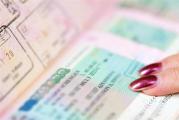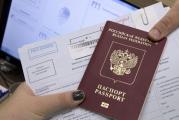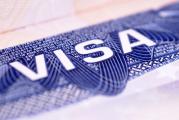How to fill out an application for a Schengen visa
If a person plans to visit European countries, then he can not do without a Schengen visa. It is she who allows you to legally stay in a number of states and freely travel around them. This applies to the Schengen countries. To obtain a visa, you need to submit a number of documents to the consulate and wait for a decision. One of the important aspects when submitting a package is a questionnaire, a lot will depend on its correct design. But not everyone knows how to fill out an application for a Schengen visa.
What is a Schengen visa?
In fact, this is a special document that will allow a person to visit countries included in the Schengen Agreement. These states include almost all those located in Europe - about 26 countries. The visa allows you to visit all of them in accordance with the specified dates of visits and periods of restriction. You can travel until the visa permit expires.

On a note! The countries do not include the United Kingdom, but countries such as Croatia, Ireland and a number of others will soon enter into this agreement. There are also a number of countries that are not included in the agreement, but are located in its area of operation - these are Switzerland, Norway, Liechtenstein and Iceland.


After submitting all the necessary visas and when the relevant authority makes a positive decision regarding the person’s stay in the country, a sticker with the applicant’s photo will appear in the foreign passport, which makes it possible to visit all these countries. However, there are several types of visas that differ in terms of validity and a number of other aspects.

Table. Types of visas for visiting Schengen countries.
| Visa type | Information |
|---|---|
| It is called "transit", it makes it possible to be on the territory of the airport of any of the Schengen states. With its help, you can not move around these countries. Required when changing flights during flights and is valid only in the transit zone of the airport. |
|
| It is also a transit visa, but is issued to those who travel by land. This visa is valid for 1-5 days. Now it is not issued. As a rule, to travel within Europe now you need to obtain a visa C, which has the designation "transit". |
|
| Short-term, useful to tourists, guests of the state or businessmen. It is issued if a person plans to stay in the territory of any state for less than 90 days. It has several formats: C1 allows you to stay in states for 30 days, C2 and C3 - up to 90 days for 6 and 12 months, respectively, and C4 - no more than 90 days for 1-5 years. Each subspecies of type C visa is, in turn, multiple (Mult), as well as either double or single. |
|
| It will allow you to stay in the country for more than 90 days and is called long-term, national. Permission is issued by each state separately. |
|
| This is a simplified road transit. It makes it possible to move between Russia and the westernmost region of the country - the Kaliningrad region. |
|
| Short-term and gives the opportunity to visit only one country. It is issued rarely, only in some special cases. Not valid even in the format of transit through other Schengen states. |

Features of its receipt
To obtain such a permit, you will need to collect all the necessary documents. These are photographs 3.5x4.5 cm (2 pcs.), Medical insurance, passport, income statement or bank statement. You will also need to fill out a special form.

Questionnaire for Schengen
It itself consists of 4 pages (2 for each A4 sheet), on which there are 37 points to fill out. A declaration is also attached to it that the person applying for a visa provides only genuine information about himself. The first 20 points relate to the identity of the applicant - the name, place and date of birth, information about the passport, information about work are indicated here. The next 10 items are information about the trip (why, where, for how many days). Also here it is required to indicate whether Schengen visas were obtained earlier. Items 31-33 inform the consulate about the host country. Here you will find the details of the hotel, information about the inviting company or information about the person to whom the trip is planned to visit.

Columns 34 and 35 are filled in only when the person submitting the application is close and dear to the EU citizen. Paragraph 36 indicates the date of registration of the questionnaire, and paragraph 37 is the place for signature.

Fill Features
The application form for obtaining a visa must be filled out correctly - the probability of obtaining a travel permit will largely depend on this. It is required to fill it out in English, as well as Russian or the official language of the state where the trip is made.
Attention! Not all consulates accept applications in Russian! Therefore, it is worth filling in the English transliteration. The name of the applicant must be written in the same way as in the passport. The name of the hotel is also indicated in Latin, or information about the inviting party is entered.

The questionnaire should not contain blots, corrections, crossed out deadlines. Nothing can be corrected even with a corrector. There should not be any blank lines in the questionnaire. For example, if the applicant does not have data that can be entered in some item, then the word “no” is written there or a dash is put, depending on the situation.
Filling out the questionnaire, if it is done manually, should be carried out only with a black pen. By the way, some countries (Latvia, Slovakia, Estonia, etc.) require the submission of questionnaires filled out only in electronic form. You can choose how to fill out the questionnaire when submitting documents to the Consulates of Germany, Poland, Lithuania, Finland. When filling out the questionnaire, it is important to ensure that capital letters are used and that the text is legible.
How to fill out the form correctly?
Let's take an example of how to fill out an application form for a trip to Spain.
Step 1. First, the personal data of the applicant is entered. This is the surname and name, patronymic is not indicated. It is required to write in the same way as in a foreign passport, not otherwise. Also, for example, if the data is entered into the questionnaire by a woman who changed her last name when she got married, then her maiden name is written in column No. 2.
Step 2 Next, the column with the date of birth is filled in, in any format, but it is best to look at the sample issued by the consulate and do the same. In the citizenship column, you need to write Russian Federation (the name "Russia" will be erroneous). In the column of place of birth, it is required to indicate the city or other municipality where the applicant was born. Sometimes you can also specify the region if the village is very small. If the name of the place has changed since birth, then the old name is indicated (as written on the birth certificate). As for the country of birth, it is also better to rewrite information from documents (maybe USSR, Russian Federation, etc.). Citizenship at birth is also better to clarify the documents.

On a note! In the questionnaires filled out online, there are no countries of the USSR. Here you have to choose a modern name.
Step 4 Clause 10 is issued only if the child needs a Schengen visa. This is where information about parents or legal guardians is entered. If the child went on a trip with an accompanying person (legally a stranger), then the data of this person does not need to be entered here.

Step 5 And point 11 is not filled in, since there is no required number in the internal Russian passport. This column is relevant for citizens of other states.
Step 6 The type of document for travel indicates "Regular Passport".
Step 8 Now enter your contact information. In the home address column, it is important to enter not a residence permit, but the place where a person lives at that time (if the addresses are different, they may be asked to bring a lease agreement, etc. It can be replaced with a certificate from work). A valid email address and phone number are provided.
Step 9 Column 18 does not need to indicate the country where the trip is made. Here you need to indicate belonging to the country. Citizens residing in Russia mark “no”, as the applicant does not have a residence permit, etc.
Step 10 The next paragraph simply indicates the position of the person at work. It’s not worth being smart - just write “manager”, “pensioner” or “student”. Naturally, in Latin or with a translation into the language of the country.
Step 11 Item 20 is information about the employer. If a person works in a company, then entering data in this column is as easy as shelling pears. The main thing to remember is that LLC is LLC, JSC is JSC.

Step 12 The purpose of the trip is tourism, if that is the case. Even when visiting a country by invitation, you can specify "tourism".
Step 13 Further in section 22, the country is indicated to the consulate of which documents are submitted. Here it is Spain. The second column indicates the country of first entry, for example, in which a transfer is made during the flight (Germany).
Step 15 If earlier visas for visiting Schengen countries were issued, then paragraph 26 indicates information about them.

Step 16 If earlier, upon receipt of previous Schengen visas, fingerprints were taken, then in paragraph 27 you must indicate “yes”. If not, then "no". Column 28 is not filled. 29 - the date is indicated no later than the one when it is planned to cross the border. Accordingly, paragraph 30 indicates the date of departure.
Step 17 In the "Location" section, you will need to provide information about the inviting party or information about the hotel where the room is booked.

Step 18 If the applicant is invited by a company, then information about the organization is entered in paragraph 32. If the trip does not belong to the category of business, then you need to write "not applicable".

Step 19 As for expenses, in the case of a regular tourist trip, it is required to put a tick in front of the words “the applicant himself”, that is, it is this person who pays all the expenses. Payment options are also indicated - credit cards, cash, etc. (left column). If the trip is by invitation or sponsored, the right column is filled in.

Step 20 But 34 and 35 points are needed only if a person goes to relatives. Otherwise, it is not filled.

Step 21 Next, paragraph 36 is filled in - the date and place of filling out the questionnaire are indicated. Clause 37 is signed. Also, signatures are put where it is written that the person is informed about the non-return of the visa fee and the need to have insurance. The last signature is placed at the end of the questionnaire and confirms the consent to the processing of personal data.

Video - How to fill out an application for a Schengen visa?
It is important to fill out the visa application form very carefully - if you make blots or mistakes, you will have to rewrite everything again. Therefore, it is better to fill it out electronically and then print it out, or enter data with special care in a quiet room where no one will distract you.




